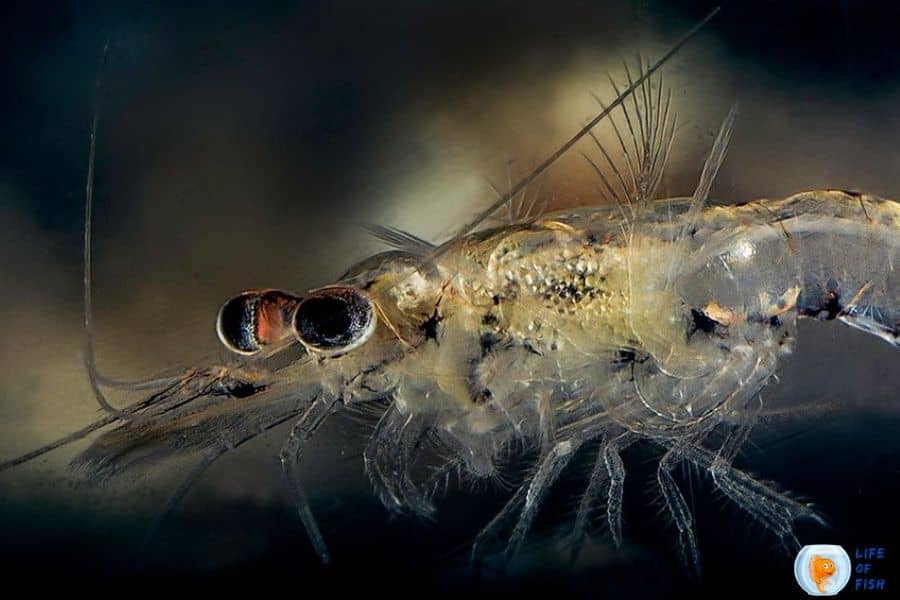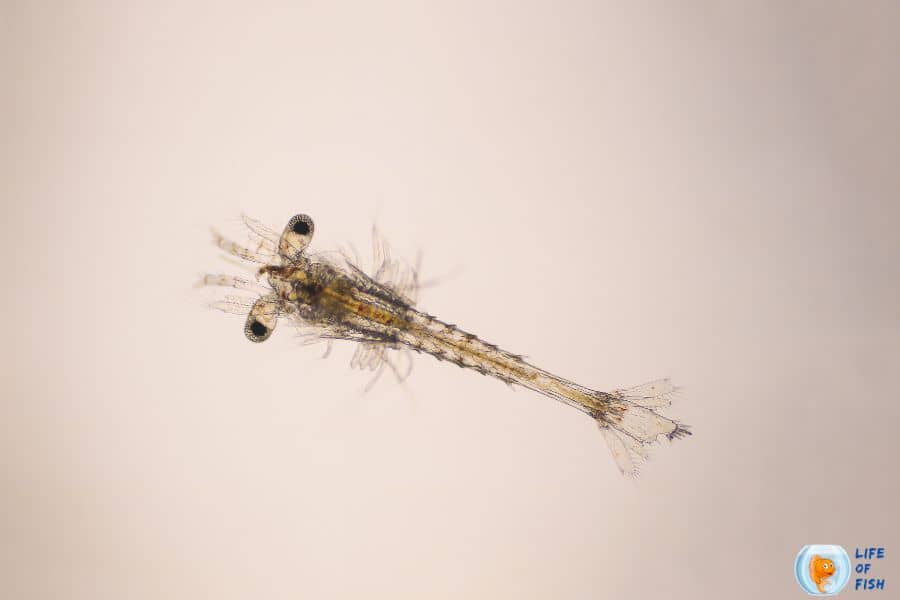How to breed Mysis shrimp? That’s the question I going to answer in this article. It is not a difficult process. but you need some experience to do Mysis shrimp breeding. In this article, I am going to explain to you how to do that step by step.

Can you breed Mysis shrimp?
Jump To
Yes, but many aquarists claim that it is not easy to raise them. The major problem is their cannibalistic behavior when they are not fed sufficiently.
Further, culturing Mysids is a fairly labor-intensive project. However, mysid culture can be accomplished by anyone who is willing to put in the time and effort.
What is Mysis shrimp?
Mysis shrimp are macroscopic crustaceans. Generally, they are called shrimp but actually, they are not shrimp.
The females of this species carry their fry in a pouch at the base of their legs in a marsupial-like manner. This is close to the shape of the shrimp and therefore, is referred to as Opossum shrimp.
There are over 72 species of Mysids. They have a wide range of sizes they can grow to, but will only get as big as an inch.
Therefore, most shrimp you find frozen or live will most likely be on the smaller side. Most of them are freshwater mysids, but there are marine species.
Where they live
Mysid shrimps naturally inhabit coastal zones across the high boreal and Arctic seas. They are also found in northern freshwater lakes.
Mysids naturally inhabit coastal zones across the high boreal and Arctic seas. They have also been found to inhabit freshwater northern lakes and the brackish waters of the Caspian Sea.
Some Mysis shrimp species inhabit shallow waters in estuaries from the East Coast of Mexico to Florida, USA.
Read More: Remineralize RO Water For Shrimp | 3 Easy Ways To Do It
You don’t want to get stressed about their environmental conditions as they are really hardy animals. They can withstand a wide range of living conditions, changing temperatures, and salinities.
Some species prefer the seabed, while others like to live in mid-water or among seagrass and algae.
Male and female mysis
Mysis show sexual dimorphism and can be identified easily. Male mysids are slightly larger than female mysids. They are readily identifiable by their conspicuous absence of the white brood pouch.
Importance
Mysis shrimp is a popular fish meal in the aquatic industry. If you have a saltwater aquarium, it is very important to make sure that the inhabitants get the best possible food, as this will help them live longer and healthier.
To achieve this, it is best to feed them naturally occurring foods such as Mysis shrimp. You can buy them or breed them on your own.
Many aquarists claim that there is no doubt that these creatures are extremely nutritious and your fish will devour them with ferocity.

How to breed Mysis shrimp?
One of the keys to raising Mysids is to prevent cannibalism by separating the adults from the young.
Although it is done manually using a pipette in laboratory studies, you need an automatic device to do it if you are planning to do it on a commercial scale.
You will need the below things to breed Mysis shrimp in your aquarium
- An aquarium with a volume of 30 Gallons
- A screen separator large enough to divide the tank in half
- A saltwater-safe powerhead
- Synthetic sea salt
- Approximately 200 live Mysis shrimp
- A plastic hydrometer that is inexpensive
- Two two-liter soda bottles washed (without soap)
- A plastic bottle carton for the soda bottles
- Brine shrimp eggs
- Two air pumps
- Airline tubing
- Brine shrimp net
- Algae
The steps of the process are described below.
Setting up Mysis shrimp tank
You will need a 30 -gallon tank for this. Fill the tank with fresh water and add synthetic salt. The amount of the salt is varying depending on the brand and the quality of the salt used.
Read More : Why Is My Fish Tank Cloudy After Water Change: 11 THINGS MUST KNOW
Adjust water quality
- Put the hydrometer in the tank on a flat surface.
- Use the hydrometer to adjust the ratio between the water and salt concentration. The required concentration is 21-22 ppt and the specific gravity to about 1.022. Set the temperature at 75-78F.
- Adjust the water volume and the salt input until you get the above value. For example, If your hydrometer is above that number, drain some water from the tank, add fresh water, and test again or if below that number, add more salt sparingly.
- The whole process depends on the correct concentration of the salt therefore, be patient and continue testing as many times as you need to until you get the proper ratio.
Add equipment
- Take the water circulator (which circulates the water) out of the packaging. You must locate the suction cup in the box and attach it to the pump.
- Place the powerhead (the water circulator) on one side of the tank with the head pointing to the opposite side by pushing down on the suction cup. Water flow is a very important factor in breeding Mysis shrimp successfully.
- Place mesh separator in the middle of the tank.
- Add algae or live rock to the tank and allow three to four weeks for a biological filter to be established.
Read More :Will Vinegar Kill Algae In A Fish Tank : Step By Step Guide
Add and take care of shrimps
- Once the tank has cycled and the biofiltration is established, add roughly 200 Mysis shrimp to the tank. Establish a photoperiod of 16 hours of light and 8 hours of darkness (Mysids mate at night), and perform 15-20% water changes weekly.
- By this time, you should keep your eye on the empty side of the tank. The mesh separator screens out the adults and the babies. As babies are born, the powerhead will push them through the mesh separator.
- Feed your adult Mysis shrimp the live baby shrimp from your hatchery twice a day.
- Make sure almost all of the feed is consumed with each feeding. It is recommended to keep the density of approximately 10 brine shrimp /ml of water to maximize growth and reproduction. Monitor the water quality of the Mysid tank closely.
- Mysis shrimp are cannibalistic. If you do not feed them the brine shrimp on a regular basis, they will eat each other therefore make sure they get enough food.
- Enriched foods are a proven way to provide nutritionally sufficient food for juvenile Mysids. Feeding fortified Artemia nauplii to Mysids is the simplest method of enriching them.
- Based on experiments performed in static (closed) systems, artemia nauplii are most beneficial for sustaining mysid colonies.
- The recommendation is to supplement adult and hatchling mysids with marine fatty acids-fortified Artemia nauplii (such as phytoplankton-enriched or Selco-enriched preparations) for 12 hours before feeding.
- Once some of the babies become adult size, move them back to the adult side of the tank.
How to Hatch Brine Shrimp
- For this, you need two empty soda bottles (plastic). Cut off the bottom of your soda bottles and place them upside down into the plastic carton with caps tightly sealed.
- Fill both bottles with normal tap water. Add one and a half to two tablespoons of synthetic sea salt.
- Allow the salt to completely dissolve before adding six to eight grams of brine shrimp eggs, available at your local aquarium store.
- Open the air pump and attach airline tubing. Run the airline tubing about halfway down the soda bottle and clip on to the rim of the bottle (do not use air stone as it will cause foaming).
- Plug in the air pump. You should see bubbles coming out of the air tube. Keep the hatching containers between 75 -80 0F
Removing Brine Shrimp for Feeding to Mysis
- This is the most challenging part of the breeding of Mysis shrimp.
- Remove airline tubing from the first bottle after 28 hours and let the contents settle.
- Open the cap on the bottle and let the settled shrimp flow into the second bottle.
- Quickly put the cap back on and begin the process in the first bottle again.
- Use a brine shrimp net to collect the shrimp you placed in the second bottle.
- Rinse the brine shrimp with fresh saltwater. The baby shrimp are now ready to be used as food for your Mysis shrimp or other aquarium life.

Mysis shrimp life cycle
Brine shrimp reach sexual maturity within 18 – 21 days after hatching and reproduce in two ways.
- Fertilize by male
In this method, the male clamps on a female with his large second antennae and fertilizes her eggs, thereby leading to the production of diploid zygotes. Afterward, the female lays the eggs in a brood sac in the water.
- Without fertilizing (parthenogenesis)
This method is common among brine shrimp. A female lays unfertilized eggs that will develop into female offspring without the intervention of a male.
The eggs will only hatch if environmental conditions are right. The ideal temperature must be around 30 C (~86F), water supply plentiful, and salt concentration not too high.
Also, the specific gravity should not be more than 1.09. If these conditions are not fulfilled, fertilized eggs are deposited as cysts and remain dried and encased in a thick shell until they are ready to develop.
The cysts may be immersed in water several times before hatching. Upon immersion in seawater, the biconcave-shaped cysts hydrate, become spherical, and the embryo resumes its active metabolism.
The cyst’s outer membrane cracks and the embryo emerges after a 20-hour interval. The embryo hangs underneath the empty shell and the development of the nauplius (larva) is completed. Afterward, the hatching membrane ruptures, and a free-swimming nauplius is born.
When they are mature enough to reproduce, the females produce young continuously, refilling their pouch with eggs as soon as their latest brood is released.
The juvenile Mysids will reach their adult size of 1 inch (1.25 cm) in about 3 weeks, creating a new generation every 30 days.
Then they go under several larval stages
First larval stage
It is characterized by a distinct brownish-orange color, a red nauplius eye in the head region, and three pairs of appendages i.e. the first antennae (sensorial function), the second antennae (locomotory + filter-feeding function), and finally: the mandibles (food intake function). The ventral side is covered by a large labrum (food intake).
The digestive tract of the nauplius is not in contact yet with the external medium. Therefore, the larva depends on its yolk reserves as the sole food source at this stage.
Second larval stage
After 8 – 12 hours of the first larval stage, it molts into the 2nd larval stage. At this stage, algae and bacteria are filtered and ingested into the digestive tract by the animal.
3rd to 15th larval stages
The larvae undergo about 15 diverse molts to grow and differentiate. During this journey, they develop their body similar to their parents.
However, you can see morphological and functional changes in the larvae only after the 10th larval stage.
In males, their antennae grow and develop into hooked graspers while the female antennae degenerate into sensorial appendages.
What do Mysis shrimp eat?
Mysis shrimp are omnivorous. They feed on different feeds. and will feed diatoms, plankton, and copepods. Some species will also eat detritus and algae.
Read Next : Is My Fish Blind? ( Causes, Symptoms, and Ways to Care )
